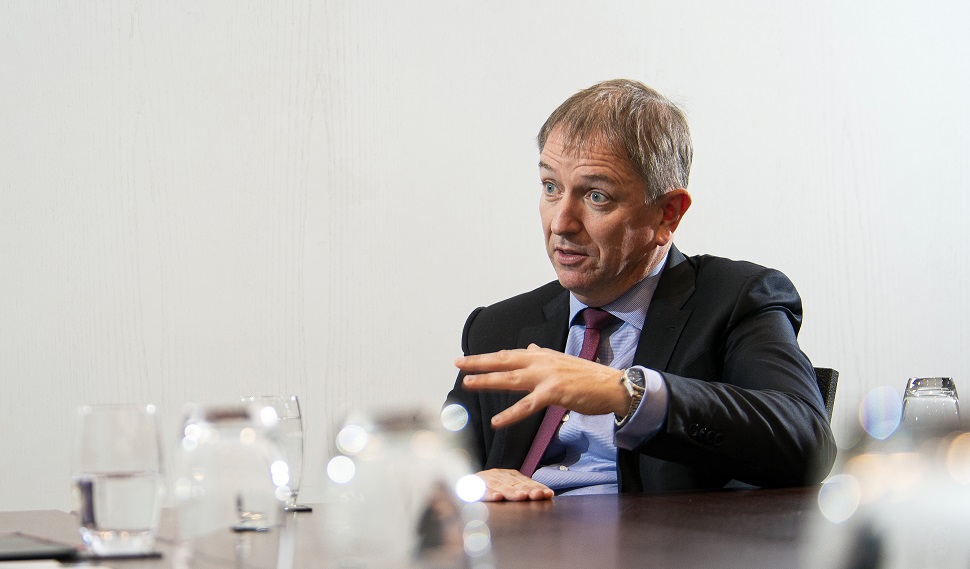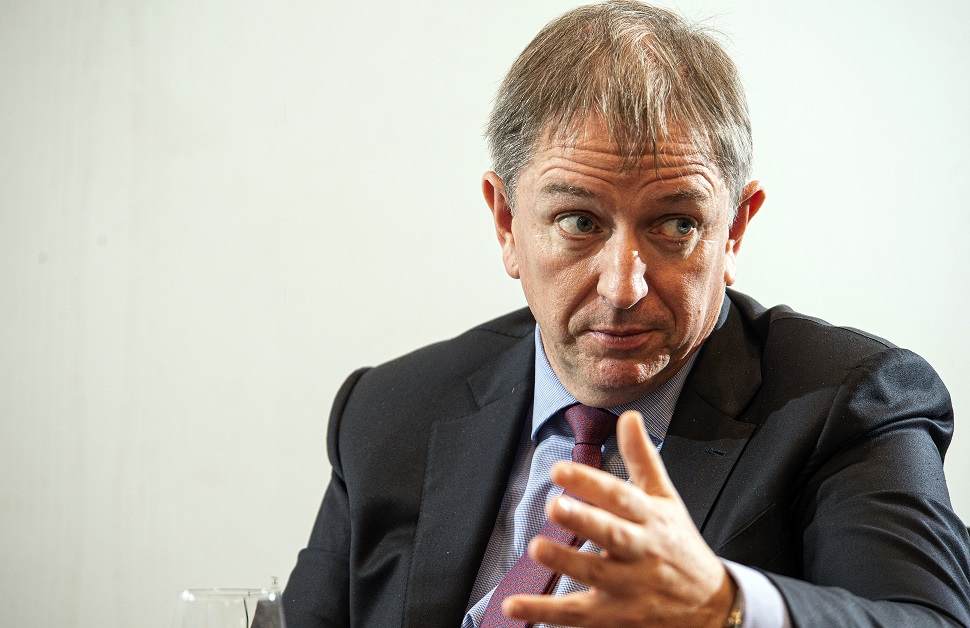Three decades ago, Peter Barrett would be sitting in a lonely office in Shannon, manning the phones at Guinness Peat Aviation (GPA). As an analyst, he had the unenviable job of staying late to finish his work and answer the phone. This was Barrett’s initiation.
When the phone duly rang late one night, Barrett, then a junior staff member, answered. On the other end? A Danish buyer of aircraft for tax purposes.
Barrett seized the opportunity, following up with the caller and sealing his fate as an aircraft trader when he closed his first deal.
It was 1990, and Barrett was 23 years old.
"It seemed unlikely, but it ended up being a trade," says Barrett, reflecting warmly on his foray into the sector.

BillyPix
After growing up in a small village in west Ireland, then completing an engineering degree and a stint at accounting firm Arthur Anderson, Barrett was employed at GPA Capital after he answered a newspaper advertisement and completed a series of interviews involving people all the way up to the president of the company.
He was hired to help structure transactions, but it was not long before he was volunteering to meet customers and investors all around the globe, including when a manager told him to buy a ticket to South Korea. He stayed in the country for three weeks and eventually closed two aircraft deals with investors.
"When you’re 23 and someone says you’re going to be paid to fly around the world, I couldn't believe that I was that fortunate to do that," Barrett says.
In those early days of aircraft trading, "the world was your oyster", he adds. "They gave you plenty of rope, and you could hang yourself or not."
Years later, in 2004, his hard work would pay off when he was appointed to the top role at one of the largest aircraft lessors in the world, then named RBS Aviation Capital.
"When I started with GPA – exactly 30 years ago – it was 10% of the world's fleet that was leased," says Barrett. "It was a niche product – there just weren't that many operating lease companies."
Now, leased aircraft account for over 40% of the global fleet, and Barrett leads the sixth-largest aircraft lessor, SMBC Aviation Capital, from its Dublin headquarters, Cirium's most recent portfolio tracker shows. Cirium values the 417 aircraft-strong portfolio at almost $16 billion.
"The quality and longevity of our platform is notable," says Barrett. That platform, through its various iterations, has been around, largely unchanged, for 19 years. "We’ve been through a number of cycles together – the way we do things, the systems, that has real value."
TOUGH PERIODS
It has not always been smooth sailing, however, especially as a boss.
Barrett has had to lead the firm through one of its toughest periods. Like many of its peers, RBS Aviation Capital was a victim of its parent's hubris. While the leasing platform continued to profit, like many distressed financial institutions, UK-based Royal Bank of Scotland was forced to sell non-core assets.
Given its years of success, RBS Aviation Capital was an obvious candidate.
In January 2012, the firm was sold to Japan's Sumitomo Mitsui Banking Corporation (SMBC), acting on behalf of a consortium comprising its parent, Sumitomo Mitsui Financial Group, and Sumitomo Corporation.
RBS Aviation Capital was renamed SMBC Aviation Capital.
"The sale of our business by our shareholders was a very difficult time," says Barrett. "There was a lot of uncertainty. Getting the ship home safely was a real sense of accomplishment."
In the end, Barrett had manoeuvred the platform to a safer harbour, and also learned a lot about liability management and diversified funding sources.

BillyPix
Barrett compares the business to climbing "a series of false summits", observing that when you reach a peak, there is always another that comes into view. "It’s a constant journey – if you're not moving forward, you’re probably moving backwards."
When it was owned by RBS, the lessor's funding came entirely from its shareholder. When RBS ran into its liquidity crisis, this had a knock-on effect for its subsidiaries. And aircraft leasing is a capital-intensive business.
So, when SMBC acquired the platform, Barrett and senior management told the new owners that its relationship with RBS had been "a strategic limitation of the business".
Today, SMBC Aviation Capital is financed about 42% from third parties, with the remainder coming from its shareholder SMBC, according to its 2018 annual report.
Barrett believes the financial structure of a leasing company should look something like this: a debt to equity ratio of 3:1; mostly unsecured debt – which is particularly important when you are trading a lot of aircraft; staggering debt maturities; prudent liability management; and, last but certainly not least, diversified sources of funding.
"Complacency and hubris are the worst things," says Barrett, noting that it is dangerous to try to simply coast along.
"Things change, the world changes and certain markets are efficient, some close down. The funding markets are dynamic, and having some optionality is important," he says, reflecting on the funding traumas he witnessed as an RBS subsidiary, and GPA's extraordinary collapse.
"It's like a real-life MBA," he jokes.
But as someone who has weathered two tough transitions, he finds silver linings from his GPA and RBS experiences. "You always learn much more in the hard times."
LONG VIEW
So, what is the ideal shareholder?
"I like to paraphrase Tolstoy," says Barrett. "Every family is unhappy in its own unique way, and shareholders are like that, they bring their own strengths. In our experience, a shareholder who takes a long view makes a lot of difference.
"At the end of the day, the liability side of the business is critical to our success, so that you’re doing it in a way that you’re not robbing Peter to pay Paul."
Since 2017, the company has raised a $500 million five-year unsecured bond each year, staggering the maturities.
And while lessors have learnt the hard way about how important it is to spread refinancings, so too have they learnt how important it is to the have the most in-demand, fuel-efficient technology.
You have to be disciplined about the aircraft on which you focus your efforts, Barrett adds. "The temptation to go off-piste is real."
Competitors like AerCap, which inherited a regional jet order from its purchase of ILFC in 2015, continue to struggle to place some aircraft. Aircastle has faced the same issue.
SMBC Aviation Capital had 418 aircraft in its fleet as of 8 November, mostly comprising Boeing 737NGs and 787s, Airbus A320 family aircraft (ceos and neos), and 12 Airbus widebodies. Its fleet also includes 20 737 Max jets that have been grounded since March, and two Embraer 190s.
Orders can be considered an asset or liability – it depends at what point you are in the cycle, the aircraft you have on order and demand. A large part of having the "best" fleet comes down to trading, says Barrett. He emphasises that it is an important portfolio management tool, and helps to strike a balance between selling not only your good assets for profit generation – which was the case at GPA, for instance – but also to cleanse the portfolio of less-desirable assets.
Much of a leasing company's success will come down to its ability to write a good lease – an aspect of the business that many believe has become sloppy, as interest in aircraft leasing has grown and new firms have entered the market over the past several years.
Barrett says a skilled underwriter will focus on the equipment first. "The right airplane is critically important," he says, noting not just the airframe, but the engines and the technical specifications.
Structural considerations for the lease will include redelivery conditions and maintenance security. Well-structured leases also give clear guidelines for your remedies if something goes wrong.
"A lot of it comes down to understanding the environment in which the airline is operating – the legal environment and the remedies available to you," Barrett says.

BillyPix
While SMBC Aviation Capital has largely avoided the big-scale bankruptcies over the past few years, the company was exposed to the collapse of Jet Airways earlier this year. It had four 737-800s on lease to the carrier – three owned and one managed. The three owned aircraft were back on lease to Brazil's Gol less than four months after the repossession process was initiated, Cirium fleets data shows. The managed 2005-vintage aircraft was sold to Jetran in May.
As the industry has evolved, several large-scale lessors have used their size to build their ancillary fees by managing others’ assets.
In SMBC’s case, its owned and managed business was divided 57% and 43%, respectively, at 31 March, according to the company’s 2018 annual report.
The company is following the industry trend of building its managed business as a service to a fund.
In July this year, SMBC Aviation Capital launched a closed-end fund – Global Aviation Equipment Leasing (GAEL) – which is made up of investments from Japanese institutional investors. The intention is to acquire up to 10 aircraft from the lessor, and then SMBC will collect fees for managing them.
Seventeen Japanese institutional investors joined one debt investor to fund GAEL.
"We hope this is going be the first of many going forward," Michael Weiss, SMBC Aviation Capital’s head of aircraft trading, told FlightGlobal when the deal was announced.
Barrett declines to specify a perfect split. "I don’t think there’s an ideal ratio, but you want to have a stock of new orders. It’s a competitive advantage to have an orderbook."
IN-DEMAND EQUIPMENT
For the most part, SMBC Aviation Capital has resisted ordering anything but the most in-demand and newest-technology equipment. The company's orderbook exclusively comprises 256 new-technology Airbus and Boeing narrowbodies.
"We typically wait to place orders, we think that’s a prudent thing to do, particularly with the last few iterations of aircraft types," says Barrett.
Last-off-the-line equipment is often unadvisable because the residual values are unpredictable. First-off-the-line aircraft – particularly in recent years with Airbus's A320neos and A380s, and Boeing's 737 Max jets and 787s – can have technical issues that require time on the ground and modifications.
"Building engines and aircraft is tough, and with increased scrutiny on the certification side, it's going to get tougher," Barrett notes, referring to the inquiry into issues with the MCAS system on the 737 Max.
While various speakers on the conference circuit wax lyrical about how great the industry is, especially the outpouring of capital, the "fracturing of globalisation", as Barrett calls it, concerns him.
"The jet-age has been a huge benefit to society and the world – there is a risk we take it for granted," he states.
With the USA and China at odds over trade, Barrett says this insular tendency could harm aviation.
"Aviation is a progenitor, motivator and facilitator of globalisation and a beneficiary of it – if that goes into retreat, it’s going to be a challenge."
Nationalist tendencies seen in the geopolitical climate over the past three years can also be felt in the managing of the return to service of the 737 Max, which has had two catastrophic accidents, says Barrett. Already, various jurisdictions have intimated that they will not take their cues from the US’s Federal Aviation Administration, which has been the traditional approach.

BillyPix
Another key issue is the environmental effect of flying. "The environmental issue is something we’re going to have to be more aware of – although it probably has more weight in some markets than others," says Barrett. "In the long term it’s a big issue for us.
"As an industry we need to tell a story in a more clear, precise way."
Aviation accounts for about 2% of CO2 emissions, according to industry trade organisation IATA. It has also become 1.5% more fuel efficient every year since 2009. Therefore, in real terms, there is less environmental impact from a mile flown today than 10 years ago.
As traffic increases, however, the fact that aircraft are more fuel efficient or "more green" does not offset the rise in the number of people flying every year. And so, technology is going to become more important, says Barrett.
Amid these challenges, Barrett notes that the industry has evolved significantly since he joined GPA 30 years ago.
"I suppose that sense of entrepreneurial experience, making new markets, creating new products, doing new things, going places where people hadn’t gone before, all came from that period," he observes.
Of course, those 'Wild West' days are now in the past.
BIGGER DEAL
"It was a very different culture from today," he recalls. "Most leasing companies are big institutions themselves or owned by big institutions now. It’s much more commoditised and a much bigger part of the industry, and it’s a more mature industry."
Many of the chief executives leading the top 20 leasing companies are veterans of what was once a wild frontier. The aircraft leasing sector is only 35-40 years old, depending on who you ask.
Some have retired, while the junior staff from the 1990s have risen to the helms of certain companies. But that first generation will start to pass the torch on soon.
SMBC Aviation Capital is investing in the future through a graduate programme that is specifically geared towards students who are interested in joining the aircraft leasing sector. Already, 25-30 individuals have joined the company since the programme began five years ago.
There is no doubt that the industry, and especially aircraft leasing, has become more complex over the decades. There is a lot happening at any given time and at multiple levels. On the micro level you may be dealing with the minutia of transactions, while at the macro level you have to stay keenly aware of geopolitical risks and what is happening at the OEMs.
And with that, Barrett finishes with some sage advice: "Pay attention, there's a huge amount to learn."























